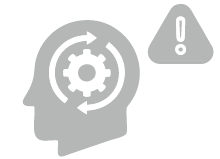Cultural Neuroscience
The last three decades of work in cultural psychology have shown substantial cultural variations in mentality. Building on this work, our recent work has explored the neural underpinnings of this variation. This effort has culminated in a new field now called the cultural neuroscience.
If you want to learn more about this effort as well as the field itself, please see the following representative publications:
- Kitayama, S., & Park, J. (2010). Cultural neuroscience of the self: Understanding the social grounding of the brain. Social Cognitive and Affective Neuroscience, 5, 111-129.
- Kitayama, S., & Uskul, A. (2011). Culture, mind, and the brain: Current evidence and future directions. Annual Review of Psychology, 62, 419-449.
- Han, S., Northoff, G., Vogeley, K., Wexler, B. E., Kitayama, S., & Varnum, M. E. W. (2013). A Cultural Neuroscience Approach to the Biosocial Nature of the Human Brain. Annual review of psychology, 64(1).
- Kitayama, S., & Salvador, C. E. (2017). Culture Embrained: Going Beyond the Nature-Nurture Dichotomy. Perspectives on Psychological Science, 12(5), 841–854. http://doi.org/10.1177/1745691617707317
- Kitayama, S., Varnum, M. E. W., & Salvador, C. E. (2019). Cultural neuroscience. In D. Cohen & S. Kitayama (Eds.), The Handbook of Cultural Psychology, 2nd Edition. Guilford.
Within the framework of cultural neuroscience, we have explored many effects, including error processing and cognitive dissonance, analytic vs. holistic cognition, spontaneous trait inference, emotion regulation, and self-referential judgment. At the present moment, however, we have spent a lot of effort on the following three foci: (i) neuroplasticity and cortical volume, (ii) norm psychology, and (iii) error processing.

Neuroplasticity and Cortical Volume
Our brain may plastically change when we actively and repeatedly engage in some set of routines available in our culture to achieve certain widely valued goals such as independence in North America and interdependence in Asia. We have called these routines “cultural tasks.” We have used structural scanning of many brains of different cultural origins to test whether cultural tasks would preferentially recruit certain regions of the brain, which in turn might expand the volume of such regions.
Moreover, to shed some light on the causal mechanisms underlying the association between culture and regionally specific brain volume, we have used a genetic method to assess environmental (i.e., cultural) contributions. Prior work provides sufficient evidence to hypothesize that some polymorphic variants of the dopamine D4 receptor gene (DRD4) increase sensitivity to social reward contingencies. People who carry these variants may then be particularly sensitive to cultural influences and, if so, these people may be especially likely to show cultural variation in cortical volume.
If you want to learn more about this project, please see the following representative publications:
- Kitayama, S., King, A., Tompson, S., Huff, S., Yoon, C., & Liberzon, I. (2014). The Dopamine Receptor Gene (DRD4) Moderates Cultural Difference in Independent versus Interdependent Social Orientation. Psychological Science, 25, 1169-1177.
- Kitayama, S., King, A., Hsu, M., Liberzon, I., & Yoon, C. (2016). Dopamine-system genes and cultural acquisition: the norm sensitivity hypothesis. Current Opinion in Psychology, 8, 167–174. http://doi.org/10.1016/j.copsyc.2015.11.006
- Tompson, S. H., Huff, S. T., Yoon, C., King, A., Liberzon, I., & Kitayama, S. (2018). The dopamine D4 receptor gene (DRD4) modulates cultural variation in emotional experience. Culture and Brain, 65(3), 1157. http://doi.org/10.1007/s40167-018-0063-5
- Kitayama, S., Yanagisawa, K., Ito, A., Ueda, R., Uchida, Y., & Abe, N. (2017). Reduced orbitofrontal cortical volume is associated with interdependent self-construal. Proceedings of the National Academy of Sciences, 114(30), 7969–7974. http://doi.org/10.1073/pnas.1704831114 Yu, Q., Abe, N., King, A., Yoon, C., Liberzon, I., & Kitayama, S. (2018). Cultural variation in the gray matter volume of the prefrontal cortex is moderated by the dopamine D4 receptor gene (DRD4). Cerebral Cortex, 11(6), 805. http://doi.org/10.1093/cercor/bhy271
- Kitayama, S., Yu, Q., King, A.P., Yoon, C., & Liberzon, I. (in press). The gray matter volume of the temporoparietal junction varies across cultures: Is it moderated by the dopamine D4 receptor gene? Social Cognitive and Affective Neuroscience.
Click here to return to our home page.
Click here to return to the top of this page.

Norm Psychology
Humans regulate behaviors in accordance with human-made rules that govern their own social behaviors. These rules are referred to as social norms. Numerous studies in social psychology investigated how social norms powerfully influence judgment and decision making as well as overt social behaviors. Moreover, social norms are also crucial in defining cultural ethos of different ethnic groups. Surprisingly, however, little is known about how we process norm-relevant information.
To fill this gap, we have investigated how people process information about another person’s behavior that violates mundane social norms (e.g., stay quiet in a library or bike in a bike lane). Often times people don’t care much about such relatively innocuous norm violations, but sometimes they do. They may very quickly detect the norm violations when they happen and, moreover, they may sustain vigilant attention to them. This vigilant processing of norm violations is likely to be an important basis of tightening of social norms that can happen at a group level. We have developed an EEG experimental paradigm to investigate an assortment of questions about the conditions in which the vigilant processing of norm violations might occur.
If you are interested in learning more about this topic, please see the following representative publication:
- Mu, Y., Kitayama, S., Han, S., & Gelfand, M. J. (2015). How culture gets embrained: Cultural differences in event-related potentials of social norm violations. Proceedings of the National Academy of Sciences, 201509839. http://doi.org/10.1073/pnas.1509839112
- Salvador, C. E., Mu, Y., Gelfand, M. J., & Kitayama, S. (2020). When norm violations are spontaneously detected: An electrocortical investigation. Social Cognitive and Affective Neuroscience.
Click here to return to our home page.
Click here to return to the top of this page.

Error Processing
Another line of cultural neuroscience work has grown out of our earlier research on cognitive dissonance. Cognitive dissonance occurs when one’s behavior violates what one would expect to the self to do or to be (e.g., being moral, competent, and honest). Hence, it is a form of error processing. In more recent years, we have used electroencephalogram (EEG) and functional magnetic resonance imaging (fMRI) to investigate the neural mechanism of error processing. The aim is to find out how this mechanism is modulated by socio-cultural factors.
If you are interested in learning more about this topic, please see the following representative publications:
- Kitayama, S., & Tompson, S. (2015). A Biosocial Model of Affective Decision Making: Implications for Dissonance, Motivation, and Culture. Advances in Experimental Social Psychology, 52, 72–137.
- Tompson, S., Chua, H., & Kitayama, S. (2016). Connectivity between mPFC and PCC predicts post-choice attitude change: The self-referential processing hypothesis of choice justification. Human Brain Mapping, 37, 3810-3820.
- Park, J., & Kitayama, S. (2014). Interdependent selves show face-induced facilitation of error processing: Cultural neuroscience of self-threat. Social Cognitive and Affective Neuroscience, 9, 201-208.
- Hitokoto, H., Glazer, J., & Kitayama, S. (2016). Cultural Shaping of Neural Responses: Feedback-Related Potentials Vary with Self-Construal and Face-priming. Psychophysiology, 53(1), 52–63. http://doi.org/10.1111/psyp.12554
Click here to return to our home page.
Click here to return to the top of this page.
